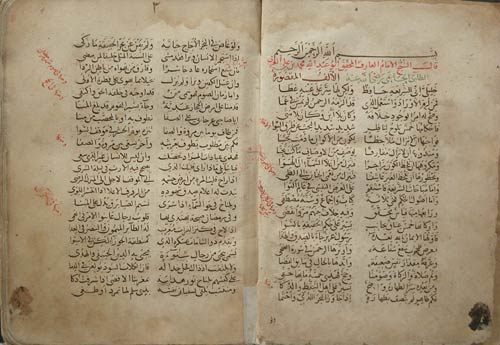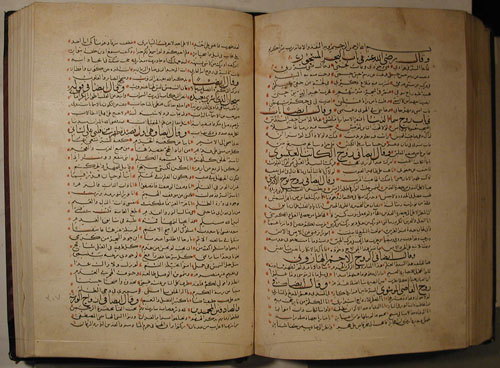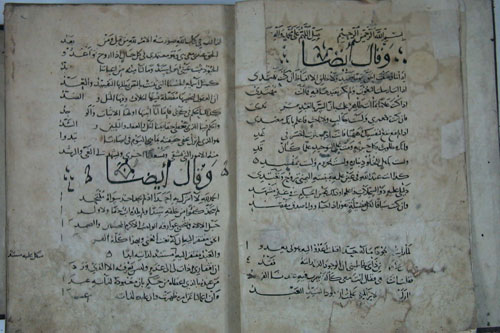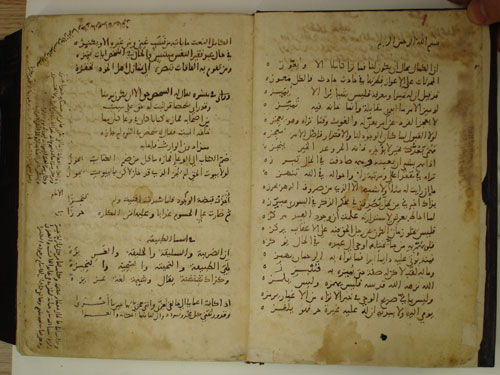Some Preliminary Notes on al-Dîwân al-kabîr
Stephen Hirtenstein

He read History at King’s College, Cambridge, and then studied at the Beshara School of Intensive Esoteric Education in Gloucestershire and Scotland. After a teaching career, he began writing and giving talks on Ibn Arabi’s thought at conferences across the world.
In addition to lecturing and writing, he organises and leads tours "in the footsteps of Ibn Arabi".
He currently works as a Senior Editor for the Institute of Ismaili Studies in London, and lives near Oxford.
Articles by Stephen Hirtenstein
The Image of Guidance – Sadr al-Din al-Qunawi as Hadith Commentator
“I entrust to you a bequest” – Ibn Sawdakin | Translation
Muhyiddin Ibn Arabi: The Treasure of Compassion
Selected Major Works of Ibn Arabi
Seleção das maiores obras de Ibn Arabi (Portuguese)
De Volta a Deus (Ibn Arabī 1182–1184) – Capítulo 5 de O Compassivo Ilimitado (Portuguese)
Some Preliminary Notes on al-Diwan al-kabir
The Brotherhood of Milk – Perspectives of Knowledge in the Adamic Clay
“O Marvel!” – A Paradigm Shift towards Integration
The Mystic’s Kaaba – The Cubic Wisdom of the Heart According to Ibn Arabi
Malatyan Soil, Akbarian Fruit: From Ibn Arabi to Nyazi Misri
Sadr al-Din al-Qunawi’s al-Nusus | with Hülya Küçük
Names and Titles of Ibn [al-]‘Arabi
Kitâb al-fâna' fi-l mushâhadah, by Ibn 'Arabi | with Layla Shamash
The Great Dīwān and its offspring: The collection and dispersion of Ibn 'Arabī's poetry | with Julian Cook
The library list of Ṣadr al-Dīn al-Qūnawī | with Julian Cook
Malik MS 4263: A Manuscript Case-study
Translations by Stephen Hirtenstein
Kitâb al-fâna’ fi-l mushâhadah by Ibn ‘Arabi
Podcasts and Videos by Stephen Hirtenstein
The Healer of Wounds: Interpreting Human Existence in the Light of Alchemy and Ascension
Reviving the Dead: Ibn Arabi as the Heir to Jesus
Introduction to the “Light & Knowledge” Conference
The Mystic’s Kaaba – The Wisdom of the Heart According to Ibn Arabi
“O Marvel!” – A Paradigm Shift towards Integration
Spiritual Life, Living Spirit – Ibn Arabi’s Meeting with Jesus and John
Alongside his contemporary Ibn al-Fârid, Muhyîddîn Ibn ‘Arabî surely deserves to be recognised as one of the most important and influential mystical poets in Arab literature. He is not simply someone who composed a few poems “on the side” while getting on with the “real meat” of his prose works, as has been suggested by Annemarie Schimmel, among others. The poetic mode is never far from any of his writings, whether developed at length in works where it forms the focus, such as the Tarjumân al-ashwâq, or implicit as in the characteristic cadences of saj’ rhyming prose that preface most of his shorter writings. Scholars have for many years been intrigued and baffled by the nature of Ibn ‘Arabî’s vast output of poetry. Not only is it huge and spread throughout his works, but it also fulfils a very specific didactic purpose: as he himself notes in the Futûhât al-Makkiyya (F.II.665), “the poetry is an integral part of the explanation of the subject-matter of the chapter”. In the light of this it might seem somewhat surprising that as yet there is no proper edition of his poetry, despite the existence of a work entitled “The Great Diwan” (al-Dîwân al-kabîr) or “the Diwan of Divine Gnosis” (Dîwân al-ma’ârif al-ilâhiyya), which Ibn ‘Arabî lists in his Fihris and Ijâza. A dîwân normally means a poetry collection which has been compiled and ratified by the author, and one would naturally expect to find the whole body of work he has produced represented in it. However, recent research has shown that the substantial collection of poems printed in Bûlâq in 1855 under the title of Diwan Ibn ‘Arabi is merely a part of the overall corpus.[1] The full extent of Ibn ‘Arabî’s poetic output remains quite a mystery.
If we turn to the manuscript base, the Dîwân in the Paris Bibliothèque Nationale (2348), entitled Dîwân al-ma’ârif al-ilâhiyya, which has 239 folios, has been described by Claude Addas, and shown to have completely different contents to the Bûlâq edition. The copy was made in India and is dated 25 Rabi’ Akhir 1094 (= 23 April 1683), nearly four-and-a-half centuries after the work’s composition. It seems to include many poems from a whole range of prose works such as the Tanazzulât al-mawsiliyya, Tarjumân al-ashwâq, Futûhât al-Makkiyya or Fusûs al-hikam, but more than half the poems have not been identified yet. Perhaps some have come from works now lost. Addas has speculated that the Bûlâq edition was a follow-up volume to this collection.
The manuscript copies which can be found in Turkish libraries seem to be equally fragmentary and perplexing. Osman Yahia lists 32 manuscripts entitled Dîwân in his Répertoire Générale, noting that they are all incomplete: some are described internally, for example, as the first or second or third part (juz’) of the Dîwân. Yahia mentions that there were originally six volumes to the whole work, and “according to a note written by the copyist in Esad Ef. 2694, Ibn ‘Arabî must have composed this six-volume work in successive stages. A critical edition of this work would thus require that all the copies be looked at.” Naturally this has deterred many from beginning what will surely be an essential and revealing, albeit arduous and lengthy, task, to establish the exact corpus of Ibn ‘Arabî’s poetry.
These notes focus on four important manuscripts which have been copied for the MIAS digital archive, three of which come from Turkish libraries, and one extremely important text in the David Khalili collection in London.

The first page opening of Diwan manuscript University 1438
University A1438, dated 911/1505, in 200 folios
The title page states that this is “the first part (al-juz’ al-awwal) of the Dîwân of the greatest master (al-shaykh al-akbar), the most perfectly realised imam (al-imâm al-muhaqqiq al-akmal), the most uniquely singular pole (al-qutb al-fard al-awhad) Abû ‘Abd Allâh Muhyî al-haqq wa-l-dîn Muhammad b. ‘Alî b. al-‘Arabî al-Hâtimî al-Tâ’î, may God sanctify his mystery and be pleased with him.”
This volume, beautifully written in dark brown with red and green ink titling and annotations in the margin, has poems arranged alphabetically, from verses ending in alif maqsûra (fols. 1b–8a), hamza (8b–19b), bâ’(19b–43b) and so on up to eight poems containing ghayn.[2] The remaining nine letters are not represented at all. At first sight this alphabetical section bears some resemblance to poems found in the printed Bûlâq edition (pp. 60 ff.), but it seems longer and the poems are more precisely ordered alphabetically. Each letter section begins with a fresh basmala and the full name of the author. Many poems can be identified as coming from particular sources: the mu’ashsharât poems are specified as are those that relate to Quranic suras. The copying date is given at the end as 3 Dhu’l-Hijjah 911 (= 27 April 1506), but there is no indication of what this “first part” was copied from.

The first page opening of Diwan manuscript Yusuf Aga 5463
Yusuf Aga 5463,[3] fols. 315–492
This copy of the Dîwân is appended to eight other works, mostly by Ibn ‘Arabî, the first of which is Chapter 560 of the Futûhât al-Makkîya copied in Mecca in 947/1540 from the original in the author’s hand, as transmitted (riwâya) by his servant (khâdim) Muhammad b. Ishâq (al-Qûnawî) and Ismâ’îl Ibn Sawdakîn.[4] Although the whole manuscript is the work of the same scribe, it is unclear whether all the works belonged together originally or were even copied at the same date. It is possible that the copy of the Dîwân was originally part of a separate or more complete collection. However, judging from the scribe’s style, it is likely to have been copied around the same date, i.e. late 940s, and most probably in Mecca.
The volume begins with eleven poems to do with ascension, which can be found in the K. al-Isrâ’, i.e. identical contents to the beginning of the Bûlâq edition. A brief comparison of the beginning and end suggests that the Bûlâq actually reproduces the contents of this volume, and this volume alone. Although the Bûlâq’s exact provenance is not known, it was printed in 1855 (AH 1271), and Elmore has speculated that it might have derived from a copy in the Dâr al-kutub in Cairo. In terms of order and content, it is not as precise as YA 5463: for example, the latter gives fuller titles to many of the earlier poems instead of the somewhat laconic “He also writes…” (qâla aydan) in Bûlâq, and I have found evidence of one or two extra poems being included. It is divided into many different sections, which appear to reflect original divisions, and ends by stating that this is the second volume (juz’) of the Dîwân. Its contents seem identical to those found in another important manuscript in the Suleymaniye library, Fatih 3872, a single volume divided into 48 sections (also somewhat confusingly called juz’).[5]

The first page opening of Diwan manuscript Veliyuddin 1681
Veliyuddin 1681, dated 640/1242, in 238 folios
This is a precious early copy made on 25th Jumâda al-Ulâ 640 (= 20 December 1242), i.e. within two years of the author’s death. At the end it states that this is the third part of the Dîwân. According to the beautifully decorated frontispiece, it was also once in the possession of the well-known Ottoman scholar and shaykh al-islam, Shamsuddîn (Molla) al-Fanârî, who owned a substantial collection of Ibn ‘Arabî books.
This volume is beautifully written in naskhi script and carefully vowelled, and the poems are often prefaced by a simple “He also writes…” (qâla aydan). As Claude Addas has noted, this formula was clearly not the work of Ibn ‘Arabî himself, but added by the copyist. Since the original would have had gaps between the poems, we may guess that these gaps are here filled with this simple formula, to clarify where each poem begins and ends. At the same time there are autobiographical remarks in the first person, which give detailed comments on the circumstances surrounding the writing of a particular poem, and these are certainly the work of the author.
In addition, we should mention here the two “lost’ volumes of the Dîwân which were stolen from the Yusuf Aga library (5501 and 5502) in Konya in the 1990s. These two volumes, which were part of the waqf library of Sadruddîn al-Qûnawî, are said to have been in Ibn ‘Arabî’s own hand, and ran to 235 and 201 folios in length, respectively. Unfortunately the library register (which is the only surviving record as far as we know) gives no details as to which parts of the work they contained. It is, however, quite possible that they may have been reproduced in one or other of the above copies, since there were many scholars who made their way to Konya over the centuries in order to make copies of the works of Ibn ‘Arabî and Sadruddîn al-Qûnawî. It is quite likely that copies of these two volumes would have ended up in other library collections in Turkey. There is some evidence to suggest, for instance, that YA 5501 was actually the first alphabetical volume as it begins with the same poem in alif maqsûra as University A1438.[6]

First page-opening of the Diwan manuscript Khalili 225
The copy of the Dîwân in the Nasser D. Khalili collection of Islamic Art in London
To our knowledge this has never before been studied in detail, and it is due to the great generosity and enthusiasm of David Khalili himself that we are able to present some preliminary remarks on it.
The manuscript is 181 folios in length on a thick cream, lightly burnished paper of excellent quality, and is in pristine condition. On fol. 1a it states that this is “the fourth part of the Dîwân of the shaykh, the imam, accomplished in knowledge and gnosis (al-‘âlim al-‘ârif) Muhyîddîn Muhammad b. ‘Alî b. Muhammad b. al-‘Arabî al-Hâtimî al-Tâ’î”. The text, which begins on fol. 1b, is carefully written in a highly distinctive hand, which combines features of maghribî writing with those of the mashriq: for example, sometimes the letter fâ’is written with a dot underneath (western style) and sometimes with the dot above (eastern style), and occasionally without any dot at all!
By comparing this with other manuscripts we can confirm without doubt that this is a copy in the hand of the author himself, as is attested by notes in other hands at the beginning of the manuscript. The manuscript is not dated as such, but like all of Ibn ‘Arabî’s works it was read aloud in front of him so that the reading and understanding could be verified. In 11 separate places there are marginal notes stating that the reading of the book had reached this point in the presence of the author, signed by Ahmad b. ‘Abd Allâh al-‘Alawî. At the end of the manuscript (fol. 180b) there is a four-line certificate by the same man, Ahmad b. ‘Abd Allâh b. Ahmad al-‘Alawî, recording the completion of the reading of the manuscript in the presence of “its author, my master and imam, the shaykh, the imam, the most knowledgeable (al-‘allâma), the uniquely realised verifier (al-muhaqqiq al-fard), Abû ‘Abd Allâh Muhammad b. ‘Alî b. Muhammad b. al-‘Arabî al-–âtimî al-Tâ’î, may God support him, … at various sessions, the last of which took place on Sunday 13th Dhu’l-Hijjah 634 [= 7 August 1237] at his blessed house in Damascus.” It seems that his readings of this Dîwân were private sessions, and that he acted as the sole checker of the manuscript (no-one else is listed as being present as listener). Ahmad al-‘Alawî, also known as al-sayyid al-sharîf Kamâluddîn in other manuscripts, seems to have been a prominent disciple in the last few years of Ibn ‘Arabî’s life: he was present at a reading of the Nasab al-khirqa in 633 (= 1236), and he attended several readings of the Futûhât in the year 636 (= 1239). He may well have been part of a famous ‘Alawî family in Malatya who, according to Giuseppe Scattolin, played a major role in transmitting the work of Ibn ‘Arabî and Ibn al-Fârid.[7]
This is followed by a barely legible two-line note in Ibn ‘Arabî’s hand: “This confirms that the aforementioned person has heard the reading of this volume and the rest of the dîwân, which make up [another] five volumes, at numerous sessions. Its author, Muhammad b. ‘Alî b. al-‘Arabî, wrote this in his own handwriting in this year [i.e. the year mentioned in the note above].” This is then followed by an apparently impromptu eight-line poem (in nûn) in the author’s hand, whose first line is identical to that of a poem in the chapter on Jesus in the Fusûs al-hikam: “If it had not been for Him and if not for us, then that which is would not have been”, but then continues in an alternative version (“nor would the envoys’ messages have come from the All-Compassionate, our Master…”).
The book comprises 23 “quires”, the standard paper or parchment unit in medieval times, consisting of four doubled sheets, making eight leaves or folios.[8] Here each has eight folios apart from the 17th and 19th, which have only six. At the beginning of each quire, with the exception of the first, on the outer leaf (i.e. fol. a) there is a number at the top indicating the number of the quire (e.g. 2nd, 3rd) while on the inside leaf (i.e. fol. b), there is a basmala in the upper right-hand corner, followed by a collection of poems arranged according to the rhyme of one of the letters of the alphabet. For example: the first quire section has 12 poems ending in zayn, followed by an assortment (fols. 0b–9a); the second quire has five poems rhyming in tâ’, followed by an assortment (9b–17a); the third has four poems in tâ’, followed by another assortment (17b–25a) and so on. In some cases there are so many poems under a particular letter that they run consecutively for several quires (e.g. lâm takes up seven, mîm five, nûn six), indicating that it is much easier to construct a rhyme with certain Arabic letters than with others. The first folio cover-page also lists the letters used in the book, for ease of reference, one assumes.
The actual contents are more difficult to determine and would require a line-by-line comparison far beyond the scope of these investigations. However, checking one particular letter, zayn, across different manuscripts produces some interesting results: of the three poems in the Beirut alphabetical version of Bûlâq, two are reproduced here in Khalili, while the third which comes from the Mu’ashsharât is found in the so-called “first” volume (University A1438, fol. 169). This “first volume” contains three other zayn poems, all of which are found in Khalili. On the other hand, there are 12 zayn poems in total in Khalili (including two that run over into the margin). In addition, these poems can all be found in exactly the same order in Veliyuddin 1681. Further checking reveals that the latter is an exact but partial replica of Khalili: Veliyuddin fols. 138b to the end (238a) correspond exactly to Khalili 1b–97a, ending where there is a certificate of reading by Ahmad al-‘Alawî at the start of the 13th quire. Thus 12 of the 23 quires, roughly half the volume, have been copied into the Veliyuddin manuscript. Even though it is technically a copy of part of the author’s fourth volume, the Veliyuddin scribe calls the whole book, somewhat confusingly, the “third part” of the Dîwân. In fact it almost certainly replicates the second half of the original “third volume” and the first half of the “fourth volume”. It must be borne in mind, therefore, that manuscript copies which name themselves as a particular volume may not correspond to the original divisions made by the author himself.[9] Veliyyudin, therefore, runs from rhymes ending in the letter dâl to the letter lâm, while Khalili runs from zayn to nûn.
What does the Khalili volume tell us about the way in which the poems were collected? It seems clear that in this volume, and we may assume in others, Ibn ‘Arabî wrote the poems down in a series of eight-page notebooks arranged semi-alphabetically. Presumably these were bound together at a later date, perhaps when the collection was deemed complete. Although the main guiding principle is by rhyming letter (though not necessarily in any standard order), when a particular letter did not generate enough poems, Ibn ‘Arabî added in other poems to make up a full quire and use the paper economically. In addition, he sometimes penned further poems in the margin, perhaps at a later juncture or even after the books were bound: the first few pages of the letter lâm, for example, have 12 of these short “extras”. However, this pattern does not seem to have been used over the whole Dîwân, as neither the Bûlâq volume nor the Paris codex seem to be arranged alphabetically.
How did this Khalili volume find its way from 13th-century Damascus to 20th-century London? While most of the journey is shrouded in mystery, there is some intriguing information on the first folio: first of all, there is a lengthy note which for some reason has been defaced by overwriting, but the name of the writer, Ibrâhîm b. Ahmad al-Sattâr (the composer), and the date Muharram 635 (= late August 1237) are visible. This note might have given some clue as to what happened after the final reading of the Dîwân, since it was written less than a month after the one at the end of the book (described above). It is also tempting to speculate whether this man could even have been a son of Ahmad al-‘Alawî. On the right-hand edge of the page there is a note by a certain Muhammad b. ‘Abd al-Rahmân al-Ansârî and the date 853 (= 1449). Below, we find the seal of the Ottoman Sultan Selim I, who was responsible for the restoration of Ibn ‘Arabî’s tomb and the building of the Sâlihiyya mosque above it when he returned from the conquest of Egypt and stayed in Damascus in 924/1518. This connection with Selim is yet more confirmation of the remarkably close relationship which the Sultan evidently felt for Ibn ‘Arabî.[10] Perhaps this copy was presented to the Sultan in appreciation of his honouring of the shaykh al-akbar? Afterwards, it appears to have passed into private hands: there is the seal of one Sayyid Ahmad Sa’îd with a note dated 1172 (= 1758/59), followed by the seal of Muhammad Zâfir al-Madanî and a note dated Safar [12]96 (= February 1879) in Istanbul stating “I have been [12]honoured with this magnificent Dîwân volume…” Al-Madanî (d.1906) was a prominent shaykh in the Madaniyya, a branch of the Shâdhilî order, founded by his father who had been a disciple of the Moroccan sufi Abû Ahmad al-‘Arabî al-Darqâwî.[11] Originally from North Africa, al-Madanî had settled in Istanbul shortly before Sultan Abdul Hamid II’s accession (in 1876), and became a key sufi figure in the latter’s pan-Islamic policy, responsible for the North African provinces.
Of the six volumes of the original work, it would appear at first sight from the above that copies of at least four may have survived. However, we should be careful not to assume anything about the correspondence of the original with the copies that are extant, especially where the term “section” or “part” (juz’) is concerned. The other manuscripts of the Dîwân in Turkish libraries and elsewhere may be found to reproduce the ones already described. It is also possible that the final two volumes are merely waiting to be discovered in the public or private libraries of the world.[12] How those that survive relate to each other, where they overlap and where they differ, which works they draw upon and which are otherwise unknown poems, and how they relate to the Bûlâq edition and to the important Paris manuscript, remains to be uncovered.
Reprinted from Journal of the Muhyiddin Ibn Arabi Society, Vol. 39, 2006.
Annotations
[1] See Claude Addas, "L’oeuvre poétique d’Ibn ‘Arabî et sa reception", Studia Islamica, 2000, pp. 23–36; idem, "Á propos du Dîwân al-ma’ârif d’Ibn ‘Arabî", Studia Islamica, 1995, 1, pp. 187–95; idem, "The Ship of Stone", in The Journey of the Heart, ed. J. Mercer, Oxford, 1996; Roger Deladrière, "The Dîwân of Ibn ‘Arabî", JMIAS, XV, pp. 50–57; Gerald Elmore, "The Bûlâq Dîwân of Ibn al-‘Arabî: addenda to a tentative description", Journal of Arabic Literature, 29, 1998, pp. 136–66.
[2] Of these eight, six can be found (ordered differently) among the seven poems in ghayn in the 1999 Beirut edition. However, the alphabetical organisation in the latter runs from alif to yâ’, while University A1438 only goes as far as ghayn.
[3] Wrongly classified by Osman Yahia as 5363.
[4] This original apparently records a reading of this final chapter dated Sha’bân 629 (May 1232), where Ibn Sawdakîn was the listener, which indicates that this is the first draft of the work since the second version was completed four and a half years later in 636 (November 1238). This important piece of information shows that the original first version of the Futûhât was held in Mecca at this time, while the original second version was in Konya in the possession of the waqf of al-Qûnawî al-Qûnawî.
[5] According to Yahia (followed also by Elmore), the date of this copy is Dhu’l-Qâda 697 (= September 1298): although the date is difficult to read, I believe that it is more likely to be 300 years later, i.e. 997 (= October 1589).
[6] According to Gerald Elmore in his Journal of Arabic Literature article, n. 13, the first poem in YA 5501 corresponds to the third poem on p. 60 of the printed Dîwân, which is identical to that which begins the University copy.
[7] See Giuseppe Scattolin, "Towards a critical edition of Ibn al-Fârid’s Dîwân", Annales Islamologiques, 35, 2001, pp. 509–12, for details of the ‘Alawî family who lived in Malatya and who seem to have specialised in mystical poetry.
[8] The original Futûhât was written on the same eight-page quires.
[9] However, it may be possible to work out where the original sections occurred because of the basmala repetitions. The Paris Dîwân has 104 sections (juz’), each of which extend over approximately four or five folios. These ‘sections’ probably imitate the original division into quires, as each begins with a basmala. At the end of the 45th juz’, the copyist says that this is the end of the first part (also juz’) of the Dîwân, but there is no explanation as to what this means in terms of the original work.
[10] According to the testimony of Uftade, Selim had a dream in which he found himself amongst a group of saints and heard one of them say that the Arab lands would be given into his hand. Subsequently he was informed that this was Ibn ‘Arabî, and he was advised to build a mausoleum for him. See The Nightingale in the Garden of Love: The Poems of Uftade, by Paul Ballanfat (Anqa, 2005), p. 9.
[11] The Ibn ‘Arabî connection in these orders is most marked: Muhammad’s father, Muhammad b. Hamza al-Madanî, also had a deputy, Muhammad al-Fâsî (d.1872), who was the teacher of the most influential interpreter of Ibn ‘Arabî of his time, Emir ‘Abd al-Qâdir al-Jazâ’irî.
[12] University A899 purports to be a copy of the "last volume", for example.
